
From the title, you may think Lineage: The Martial Arts Strategy Game involves a lot of kung-fu kicking and punching a la Crouching Tiger, Hidden Dragon. But it’s actually more of an abstract strategy game inspired more by martial arts philosophy rather than outrageous fighting moves. That said, it’s a game with a lot of depth and beauty to it, and worth your while to take a closer look—it’s currently on Kickstarter seeking funding.
At a glance: Lineage is for 2-6 players, ages 12 and up. It takes 1 to 3 hours to play, depending on the number of players. The pledge level for a copy of the game is only $39, which includes shipping within the US. (An additional $30 is required for those outside of the US.)
Components
As you can see from the photo at the top, there are a lot of pieces in the game:
- 25 double-sided octagonal terrain tiles
- 36 double-sided square tiles
- 163 glass “chi” tokens (30 each in blue, red, yellow, green silver; 13 black)
- 6 “lineage markers” (4-sided dice)
- 5 Student pawns
- 5 Master pawns
- 1 Emperor pawn
- 1 General pawn
- 95 cards
The prototype is absolutely gorgeous, though obviously final results are subject to change. For instance, the octagonal tiles in this protoype set are polyurethane, but the final will be cardboard. However, the wooden square tiles will still be wood, and the pawns will also be wooden cubes (unless a stretch goal unlocks miniatures for the Emperor and General).
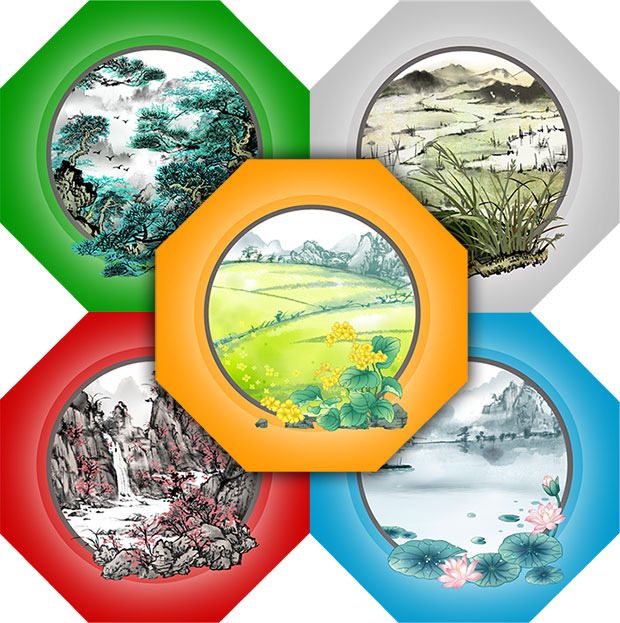
The artwork on the tiles and cards is by a Chinese artist, Yan Li: the terrain tiles are traditional Chinese paintings depicting forests, lakes, mountains, marshes, and fields. There are cards depicting various types of animals, and these are more stylized but fit really well with the theme.
I’m guessing the final game won’t come with the little plastic containers to hold the glass beads, but everything else is pretty close to what the final game should look like.
The one component that really needs work is the rulebook, which is currently in draft form. (You can download a copy of the PDF here.) I think more diagrams and examples would help explain the rules, which are pretty complex until you get the flow of the game.
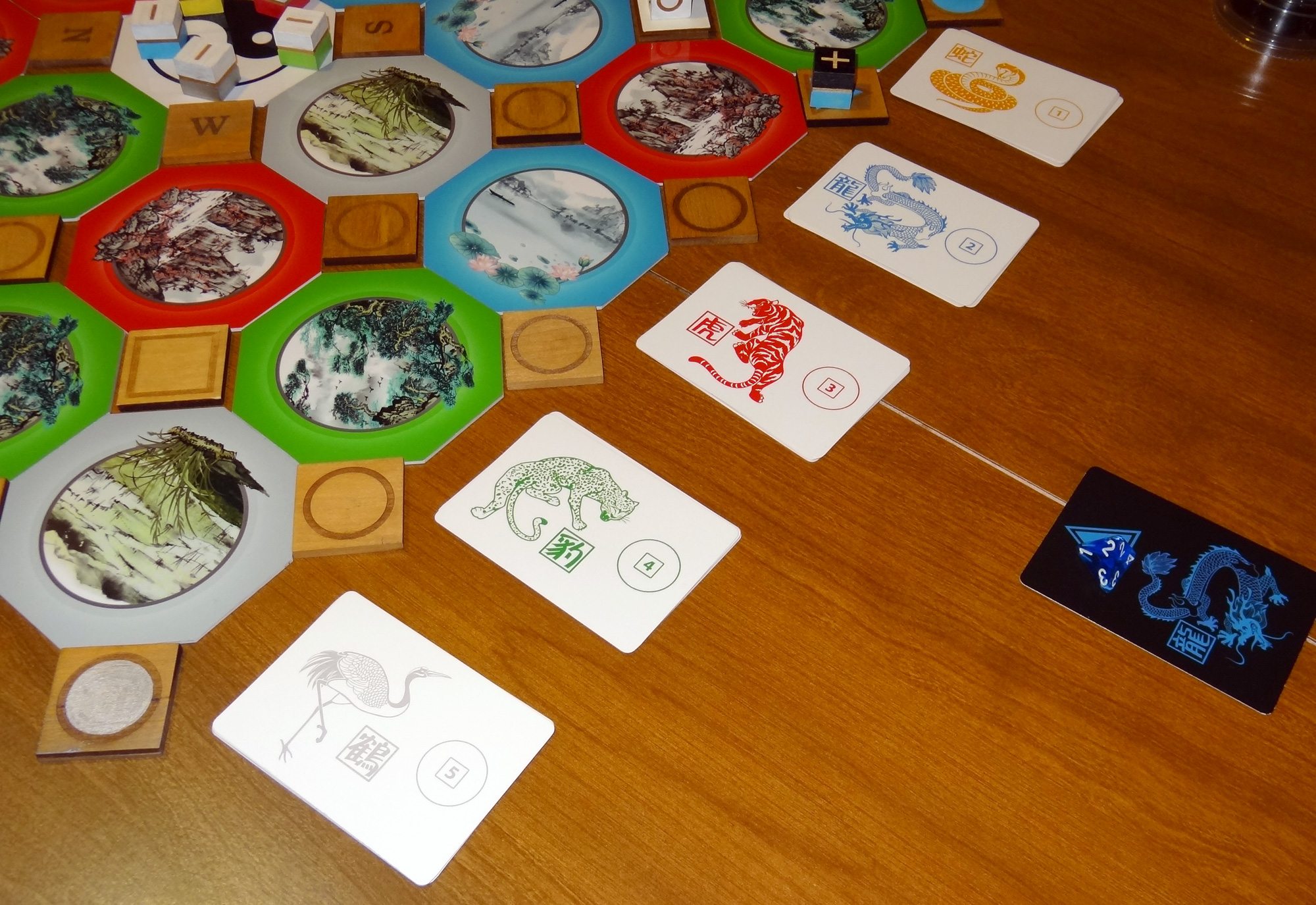
How to Play
Since the 2-player game is slightly different I’ll focus on the 3-6 player game first.
Objective
Most of the players will each be controlling a Master and a Student—their objective is to train the student (by claiming 5 Animal Cards), and then move the Master and Student both back to the center tile. One player will control the Emperor and General—the Emperor wants to unite the kingdom under one banner, and wins by placing markers on the four corners of the board.
Setup
Gray Wolf Games has posted a video of the setup process here.
The board setup is randomized, with a few static elements: the center tile must always be surrounded by one of each season (Spring Forests, Summer Mountains, Autumn Marshes, Winter Lakes), and the four directional tiles. The “Yin Yang” wooden tiles are placed to the north and south of the center tile beyond another row of terrain, and the four corners must be towns (the tiles with circles) representing Wood, Fire, Metal, and Water. The rest of the terrain tiles are randomly placed to fill out the board, and the other square tiles are randomly filled in (color-side down), though temples and palaces cannot be directly next to other locations of the same type. Finally, the 5 temples (triangles) are turned face-up to reveal their colors.
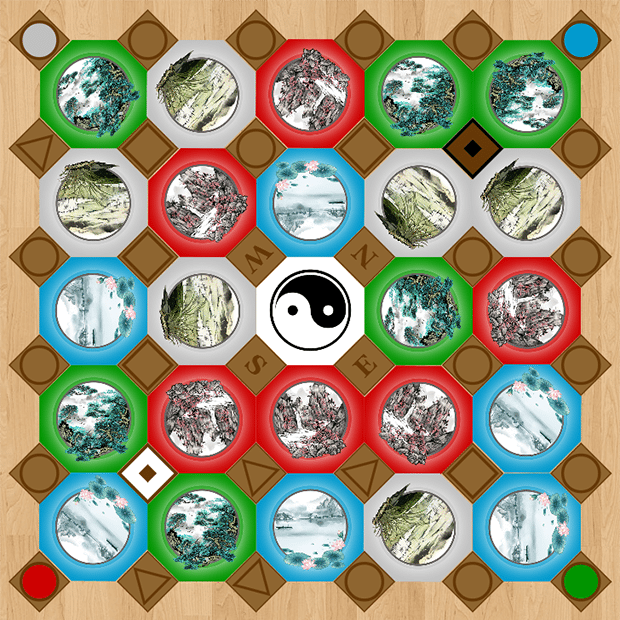
The temple cards are arranged in order—spring, summer, autumn, winter—and the palace and town cards are each shuffled into their own decks. Each player gets a lineage card and the lineage marker, a four-sided die matching their color. Masters start on their matching temple, and Students start in the center, color-side down. The Emperor and the General start on the white and black Yin Yang tiles, respectively.
Finally, the Emperor/General player may now flip over five terrain tiles (to the orange Field side) and place black glass beads on them. These are now “blocked” terrain. The Master/Student players go first, and the Emperor/General player goes last.
How to Play
(Just a warning: this section is pretty long, but if you’re not interested in all the details you can skip down to “The Verdict” below.)
Each player has a white pawn (Student or Emperor) and a black pawn (Master or General). The current state of the Yin Yang tiles determines which pawn can be moved: if they both show one color, then the pawn of that color must be moved; if one is black and one is white, then the player gets to choose which of their pawns to move. The Yin Yang tiles are flipped over whenever it transitions from occupied to unoccupied—you have to spend a turn on the space, and then when your pawn leaves, it triggers the change.
Nobody is allowed to move into the center tile until their student has collected all 5 Animal cards, but occasionally players may be sent to the center tile if their pawn is completely blocked when they need to move it. You also may not pass over the compass direction tiles, but any other tiles can be occupied. There are various rules for which pawns may share spaces—in general you can’t share a space with a pawn of the same type, and nobody can share a space with the Emperor. Masters and Students are also prevented from passing through spaces with black chi on them. The General, on the other hand, may not step on octagonal tiles unless they’ve been flipped to the Field side. Finally, the current season (as shown on the Temple cards) makes that particular terrain type impassable to all players—for instance, in the Summer, nobody can travel on mountain tiles.
You can move up to three spaces for free, and spend chi tokens to move additional spaces. Landing on a square tile will gain you a chi token of that color (square tiles are flipped over and revealed as they are explored) as well as turning over a card of the corresponding type—temple (triangle), palace (square), or town (circle). Players may then spend chi tokens to push or pull (depending on the pawn) nearby pawns. Masters and the General also get to roll their 4-sided die each time they move, collecting extra chi tokens.
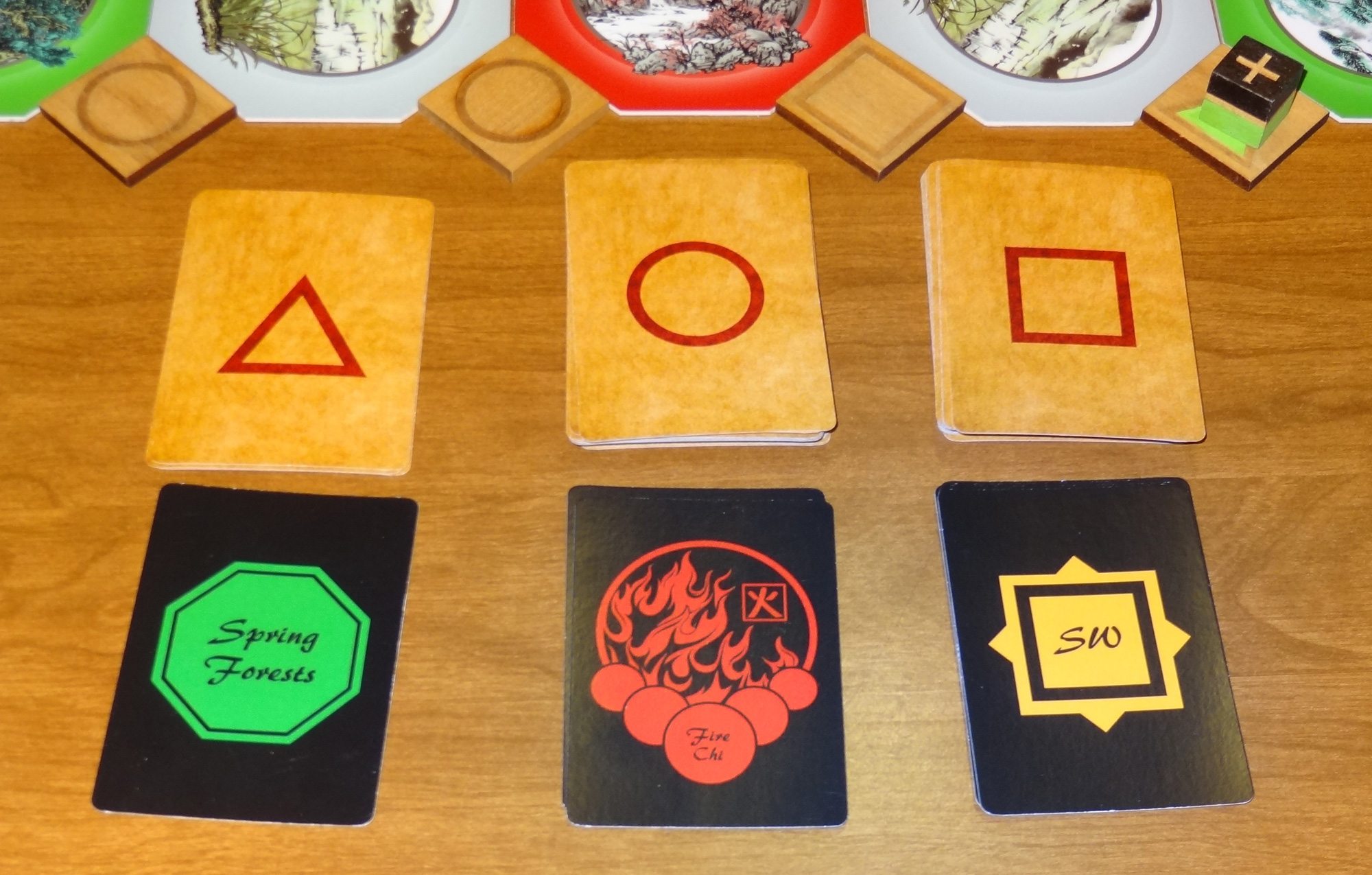
Each time a player lands on a temple, a new temple card is flipped, changing the season and affecting which terrains are impassable. Landing on a town flips a town card, which indicates the type of chi that can be spent (for extra movement, pushing/pulling players, and unblocking spaces). Finally, landing on a palace flips a palace card, which allows the player to turn over an unoccupied, unblocked terrain space in the indicated direction. Landing on a palace that matches the color of the currently-showing card lets you flip two terrain tiles instead.

To clear the black chi placed by the Emperor/General, players may spend 5 chi tokens while moving through the space. They can also combine chi tokens from other players adjacent to the affected space if the others are willing. Since you can only spend chi of one type (as indicated by the town card), you can also trade in chi at the beginning of your turn—2 of any type for 1 of another.
The Students are trying to train five times, collecting cards numbered 1 through 5 by ending a turn on the same space as the corresponding master. For example, if the top “1” card is the yellow snake, then all the students are trying to meet up with the yellow Master, wherever it may be. But once that card has been collected, that means everyone else is going for the next card in the stack, which may be the silver crane instead. In the meantime, the student who was trained is now on to the second card.
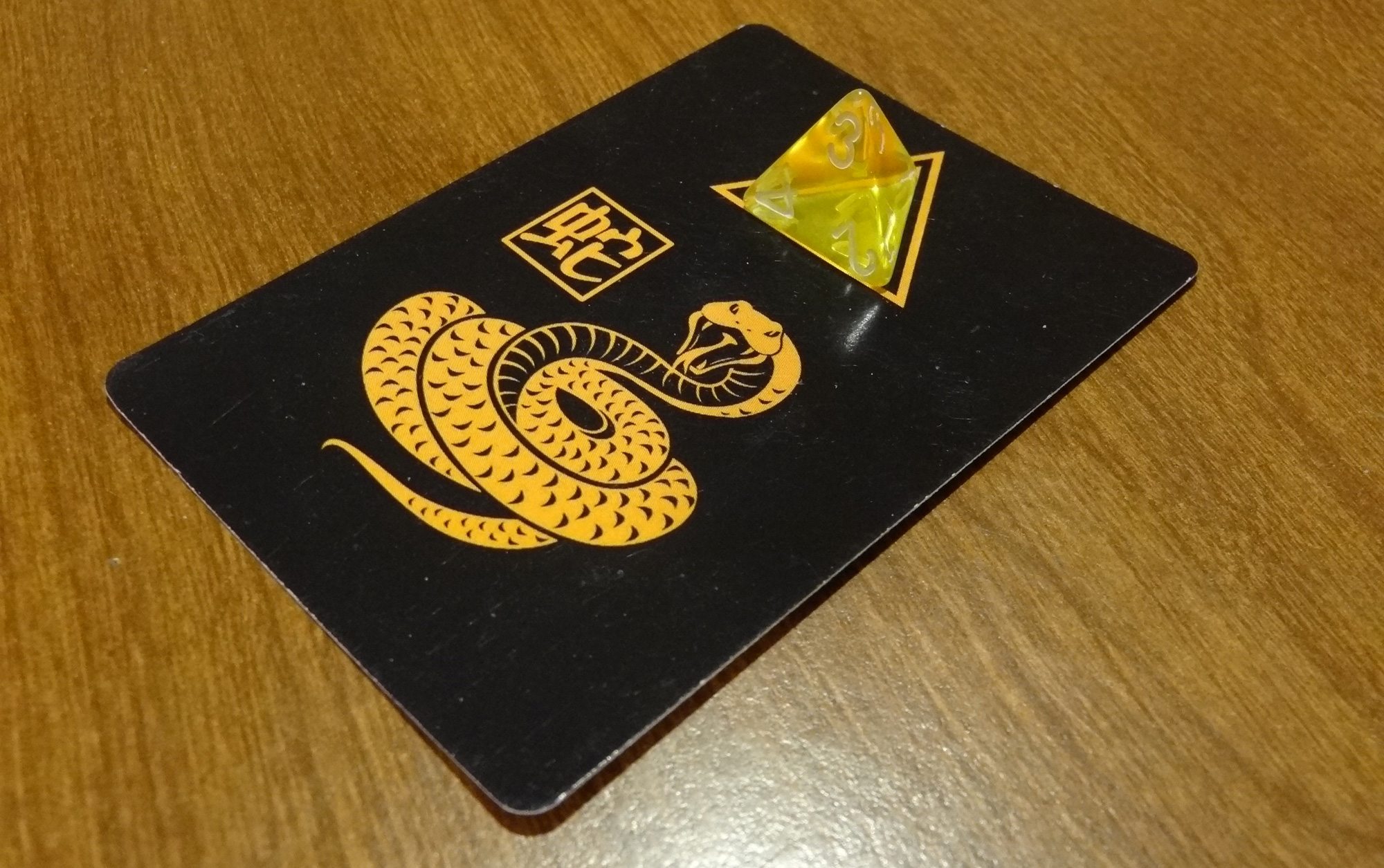
It’s important to note that you’re generally trying to track down the Master to get trained. However, if a Master gets blocked and is sent to the center tile, the corresponding lineage marker (the 4-sided die) is placed on that Master’s temple—and now students must go to the temple to train. The Master has to return to the temple in order to reclaim the lineage marker.
For the Emperor/General player, the goal is to get to the four corners of the board and block them. The Emperor turns terrains into fields and can block them; the General can block towns but needs fields to travel through. And since no pawn can share a space with the Emperor, it means the Emperor often needs to open up a field and then get out of the way before the General can pass through.
There’s one other powerful ability that the General has: conscripting Students. If the General ends its movement on the same space as a Student, that Student is placed sideways on the center tile, and may not be used by its owner. The next time the Emperor moves, the Emperor/General player then takes a turn with each conscripted student, after which they are returned to their regular owners. What makes this so powerful is that conscripted Students can do all the things that the Emperor and General usually do—flip and block terrains, block towns, collect chi, and so on—but they aren’t limited to traveling on fields and they can travel through blocked spaces. So if a General manages to conscript a student, then it’s possible for the Emperor/General player to spend enough chi to move that student all the way to a corner of the board to block the town there.
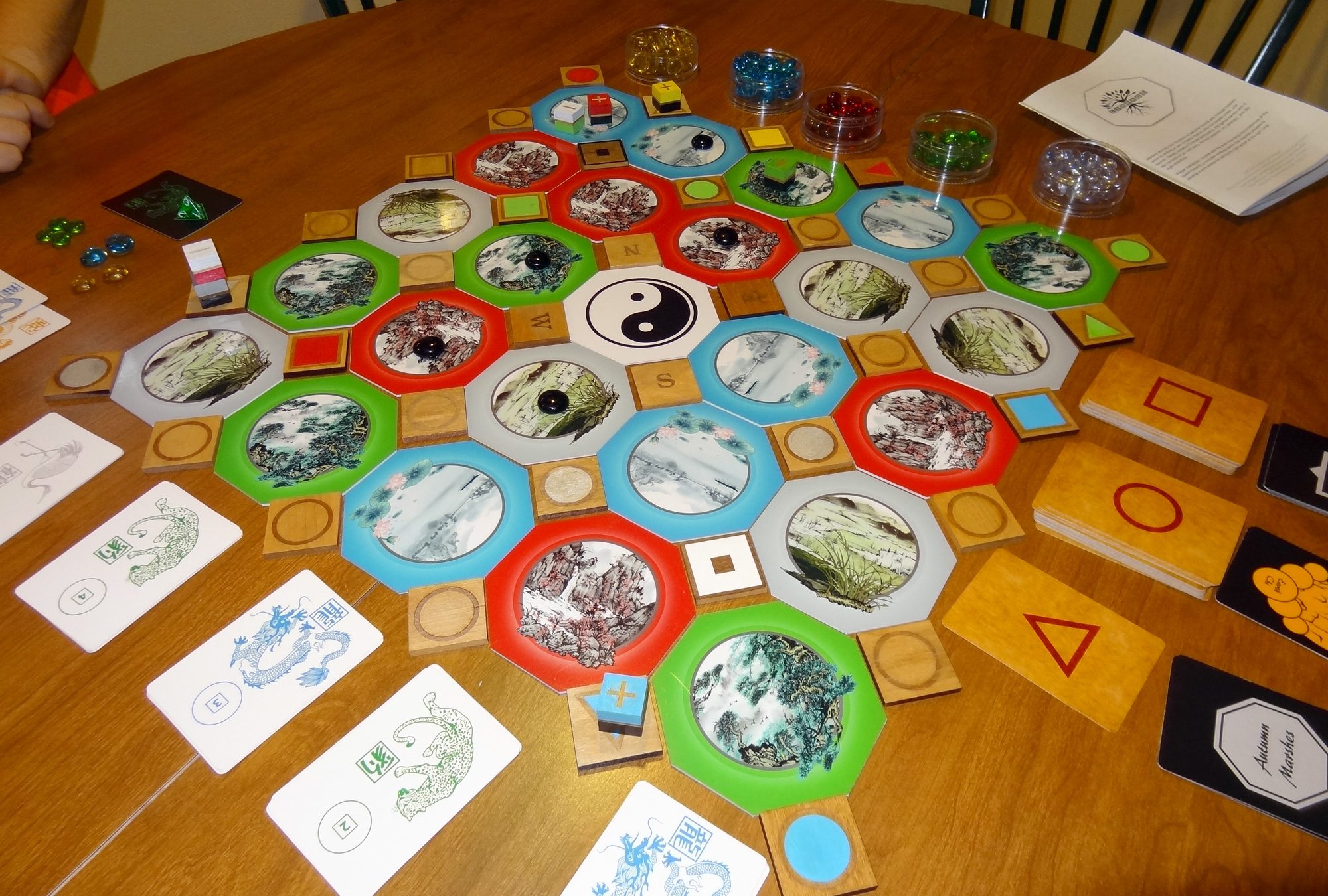
2-player variant
In the 2-player version, there is no Emperor/General player. The palaces have a different effect—instead of letting you flip over tiles, they allow you to place black chi to block paths. If the black chi tokens run out, then players may move a token from the board to another space instead. Otherwise, the objective of the game is the same.
The Verdict
When I first saw the Kickstarter video for Lineage, I really wanted to find out more. The game looked beautiful, and I was really curious about the philosophy that went into the game’s design. Justin Waggle of Gray Wolf Games was kind enough to send me a prototype so I could try it out, and it’s probably the most impressive prototype I’ve seen—sadly, I have to return it when I’m done, but I’m backing the project to get my own copy.
First, Lineage seems like a steal for the components alone. Waggle told me that he was willing to bring the price down on the Kickstarter in order to get the games into the hands of as many gamers as possible, and $39 seems like the sort of price that won’t be turning much of a profit. The funding goal ($40k) has been set at a high bar, though, so he won’t get stuck producing it unless he gets enough for a large order.
Of course, beautiful components by themselves aren’t always reason enough to buy a game, so the real question is: how does it play?
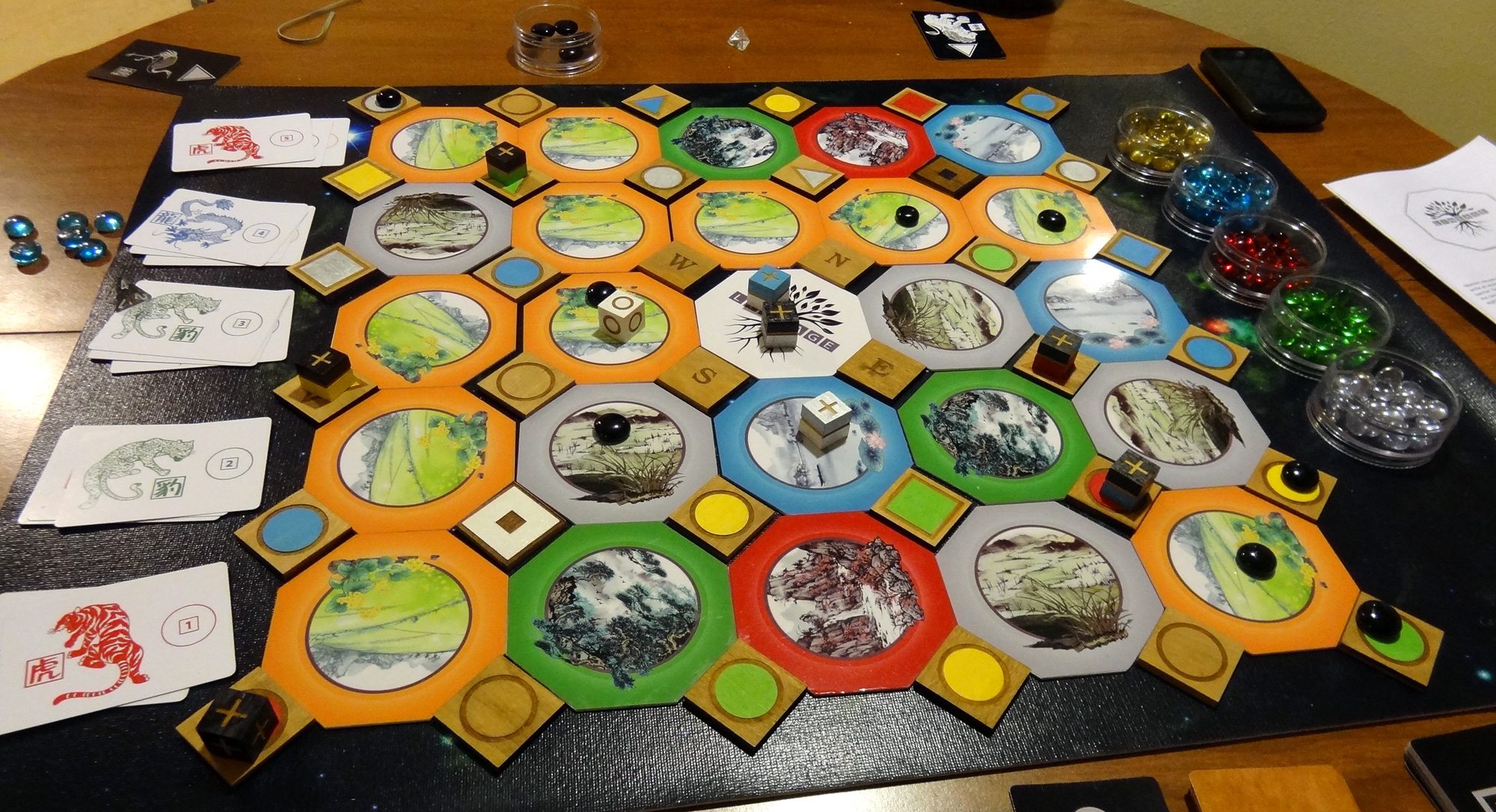
So far I’ve played it a few times, and I’m definitely enjoying it. The rulebook is still in draft form and as you can see from my explanation above there are a lot of rules to keep track of, so a well-organized rulebook (or the planned how-to-play videos) will go a long way toward making it easier to learn the game. I think it takes a few rounds before you get the hang of the gameplay, and then you really should play it again to start working out strategy. The nice thing, though, is that there isn’t a bunch of text on the cards or the board that you have to read every time you move—once you’ve picked up the basics of moving around, it starts to make sense.
I love games that have asymmetry in them—in this case, between the Master/Student players and the Emperor/General player. Although they’re moving around on the same board, they’re after different goals, and those lead to conflicts, both direct and indirect. The Master/Student players have to figure out how to work together to prevent the Emperor/General from winning, but then they’re also trying to secure victory for themselves. It leads to a delicious sort of tension—do you pursue your own training, relying on another player to stop the Emperor, or do you stop him yourself but allow the other player to pull ahead?
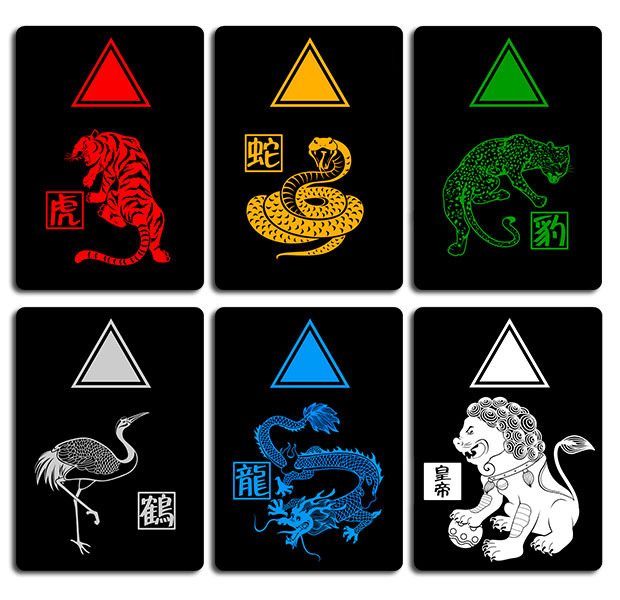
The locations effects are great, too: using temples to change up the seasons can be a really effective way to trap other players and block off routes temporarily. Since the towns affect what type of chi you can spend, sometimes you want to change it up (if another player has a lot of the current type). The palaces let you flip terrain over, but you’re taking a gamble that you’ll draw a direction card that helps you.
The Yin-Yang tiles are also a fascinating feature but they can be tricky to manage. Flipping both to black or white means that each player only has access to one of their pawns—it makes it possible to trap a player, costing them a turn (on top of the other penalties), and it can buy you time when the Emperor and General are on a roll. Of course, you should also have a plan in place to flip it back, because you can’t win the game with only one pawn.

With only a few plays under my belt so far (does that make me a white belt?), I certainly haven’t experienced the full depth of the game yet, but it’s enough to convince me that it’s worth backing and playing more. I’m particularly interested in how it plays with even more players. With three, it does feel that the Emperor/General player has a lot of power and it takes a concerted effort to stop him; with more Master/Student players there will be a lot more chi available as a group to unblock spaces, but it also means a lot more students for the General to conscript. I think maybe 4 or 5 players might be the sweet spot, though the game will be fairly long at that point.
I was curious about how Taoist philosophy and martial arts influenced the gameplay, so I was pleased to see Waggle’s interview with Bin Lee of Part Time Movie Guy. (Note to parents: the video does include some language and content that may not be appropriate for kids.) Waggle explains the gameplay and also details how the colors, seasons, animals, and elements are tied to the philosophy. I think it would be great to have a brief primer somewhere in the rulebook just to explain some of the different elements, though I guess that’s the “Lineage concepts book” mentioned in some of the reward levels.
The look of the game is great, and there are only a few things that I could see changing as far as the appearance: I’m not a fan of the font used for the directions on the palace cards (which can be hard to read), and the temple cards with the seasons look kind of bland when compared with the artwork on the terrain tiles or even the animal cards. Maybe the Chinese characters for the compass directions would be a nice touch, with an English initial (a la mahjongg tiles). But that’s fairly minor—the board and pieces themselves are fantastic.
The rulebook does need a good bit of reorganization. Any game with so many details needs to have a rulebook that is clearly laid out, and I think that may be one of the biggest challenges for Gray Wolf Games after securing funding. I know Waggle is planning to do an overhaul, and I’ve volunteered my assistance as well—but one of the great things about Kickstarter is that you’ve got an entire army of backers who can help you spot mistakes and make suggestions, as long as you don’t get stuck in design-by-committee.
The two-player game, in my opinion, isn’t as interesting, because you don’t get the Emperor/General player in the mix. It may be a good game to introduce the basic concepts and movement because both players have the same set of rules, but I think the asymmetric play is where it really shines. It may be possible to run through just a couple rounds without the Emperor and General so that people get an idea of the basic movement and use of chi tokens, but otherwise I’d recommend getting at least three players if you really want to get the full experience.
Bottom line: I think Lineage is worth backing. It’s beautiful to look at, fascinating to play, and the price is right. You will have to wait a bit—the delivery date is set a year from now—and it sounds like Gray Wolf Games is trying to avoid overpromising in that regard. Or, if you can’t wait that long, you could pledge $1,500 for a designer copy that’s shipped as soon as the Kickstarter campaign ends. (I guess that’s what I have in my hands now … wish I could keep it!)
Visit the Kickstarter page to make your pledge today!
Disclosure: Thanks to Justin Waggle of Gray Wolf Games for loaning a prototype for this review!
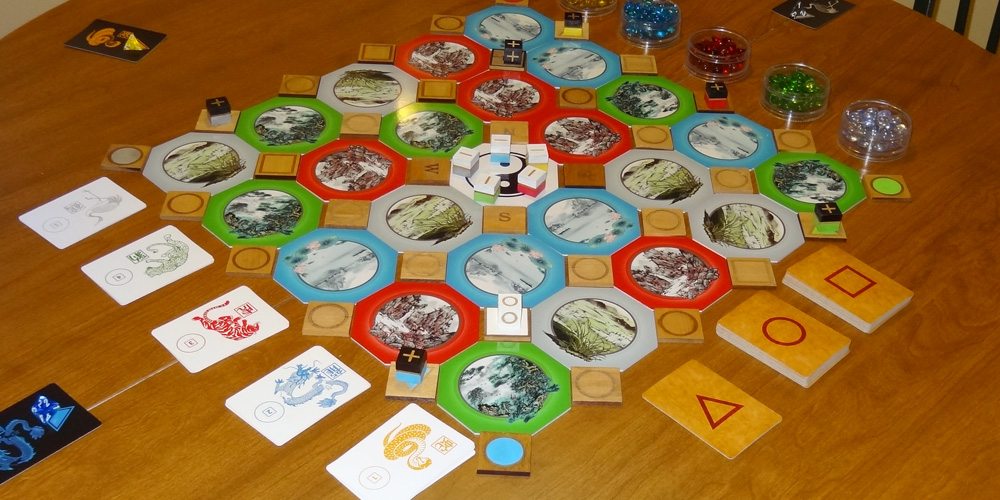




Great review for a great game! Thanks Jonathan!